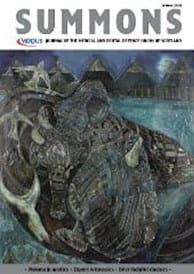THE factors which determine success in any one surgical career can be difficult to analyse. A compassionate concern for patients and a meticulous attention to detail are two which most would regard as essential. Norman Dott had both of these in abundance: his compassion for patients sharpened by his own experiences, and his attention to detail the result of his training in and aptitude for engineering.
Norman McOmish Dott was born in Colinton on the southern outskirts of Edinburgh. His forbears were Huguenots, originally called D’Ott, who had settled in Fife and his grandfather, Aitken Dott, had founded the Firm of Art Dealers, Aitken Dott and Son (now trading as The Scottish Gallery) in Edinburgh.
His father, Peter Dott, developed the firm and in his early days was a supporter of the Scottish colourists, particularly SJ Peploe and William McTaggart.
After schooling at George Heriot’s School, Dott became an engineering apprentice. Riding his motor cycle home one day he was involved in a collision which resulted in multiple fractures of the left leg. In The Royal Infirmary he came under the care of Henry Wade who decided not to amputate the leg. The incident left him with a permanent limp but inspired him to pursue a career in surgery.
The following year he enrolled as a medical student in Edinburgh, graduating in 1919 and becoming a resident in The Royal Infirmary. After obtaining the Fellowship of The Royal College of Surgeons of Edinburgh, he worked as a lecturer in physiology under Professor Sharpey-Schafer who had marked him out as an outstanding student. Here his researches included the effects of pituitary ablation, work which led to the award of a Rockefeller Fellowship with Harvey Cushing, in Boston. If Godlee (Joseph Lister’s nephew and biographer), Macewen and Horsley were the pioneers, it was Cushing who refined and made safe modern neurosurgery. Working with Cushing inspired the young Dott – both were perfectionists, original thinkers and tireless workers.
Returning to Edinburgh in 1924, Dott embarked on a career in surgical neurology. The facilities did not exist for this fledgling specialty and he was required to improvise. His initial appointment was to the children’s hospital, where he established the equipment, but adult neurosurgery was performed in nursing homes to which he took his equipment by car or taxi.
In those early days his repertoire encompassed much of paediatric surgery and he would later commend this as valuable training for any branch of surgery. His observations on the malrotation of the intestines in the neonate, published in 1924, and illustrated with his own drawings, helped both the understanding and management of this condition and the paper remains a classic to this day. It was Sir David Wilkie, Professor of Surgery, who offered him adult beds in The Royal Infirmary which led to the establishment of the Neurosurgical Unit in Ward 20.
As a result of his drive, the Department of Surgical Neurology at the Western General Hospital was established and he was largely responsible for the design. His pioneering spirit resulted in some notable innovations. He was the first person in Britain to demonstrate an arterio-venous malformation in the brain using angiography. He pioneered the operation for treating aneurysm of the middle cerebral artery by wrapping the lesion with muscle.
Throughout his life he retained his engineer’s love of design and invention. His clamps for intestinal anastomosis remained in use in Edinburgh until the end of the 20th century. He designed retractors, traction callipers and operating tables, all with an engineer’s precision and care for detail. Well into retirement he responded to the challenge of a colostomy by establishing Edinburgh’s first stoma clinic, inevitably designing and producing his own stoma appliances and devices.
Norman Dott was the first holder of the Chair of Neurological Surgery in Edinburgh and was instrumental in establishing The British Society of Neurological Surgeons. He became President of that Society and Vice President of The Royal College of Surgeons of Edinburgh and was gazetted CBE. But of the many honours which came his way, that which he said gave him greatest pleasure was being made a Freeman of his native City of Edinburgh in 1962.
His philosophy of “do what is best for the patient” endeared him to the lay public to a greater extent than that enjoyed by most surgeons. Perhaps this was the result of his lifelong experiences as a patient – saved from an amputation by Sir Henry Wade, having a chronically painful hip fused by Sir Harry Platt, leg shortening by Sir Walter Mercer, a cordotomy for chronic pain by his friend Sir Geoffrey Jefferson and a colostomy by Tom McNair. Experiences of life as a patient undoubtedly contributed to his greatness as a surgeon.
Iain Macintyre
Grateful acknowledgement is made to Iain Macintyre FRCSEd and Iain Maclaren FRCSEd, and the Royal College of Surgeons of Edinburgh for permission to publish this article adapted from the book Surgeons’ Lives published by the RCSEd in 2005.
This page was correct at the time of publication. Any guidance is intended as general guidance for members only. If you are a member and need specific advice relating to your own circumstances, please contact one of our advisers.
Read more from this issue of Insight

Save this article
Save this article to a list of favourite articles which members can access in their account.
Save to library